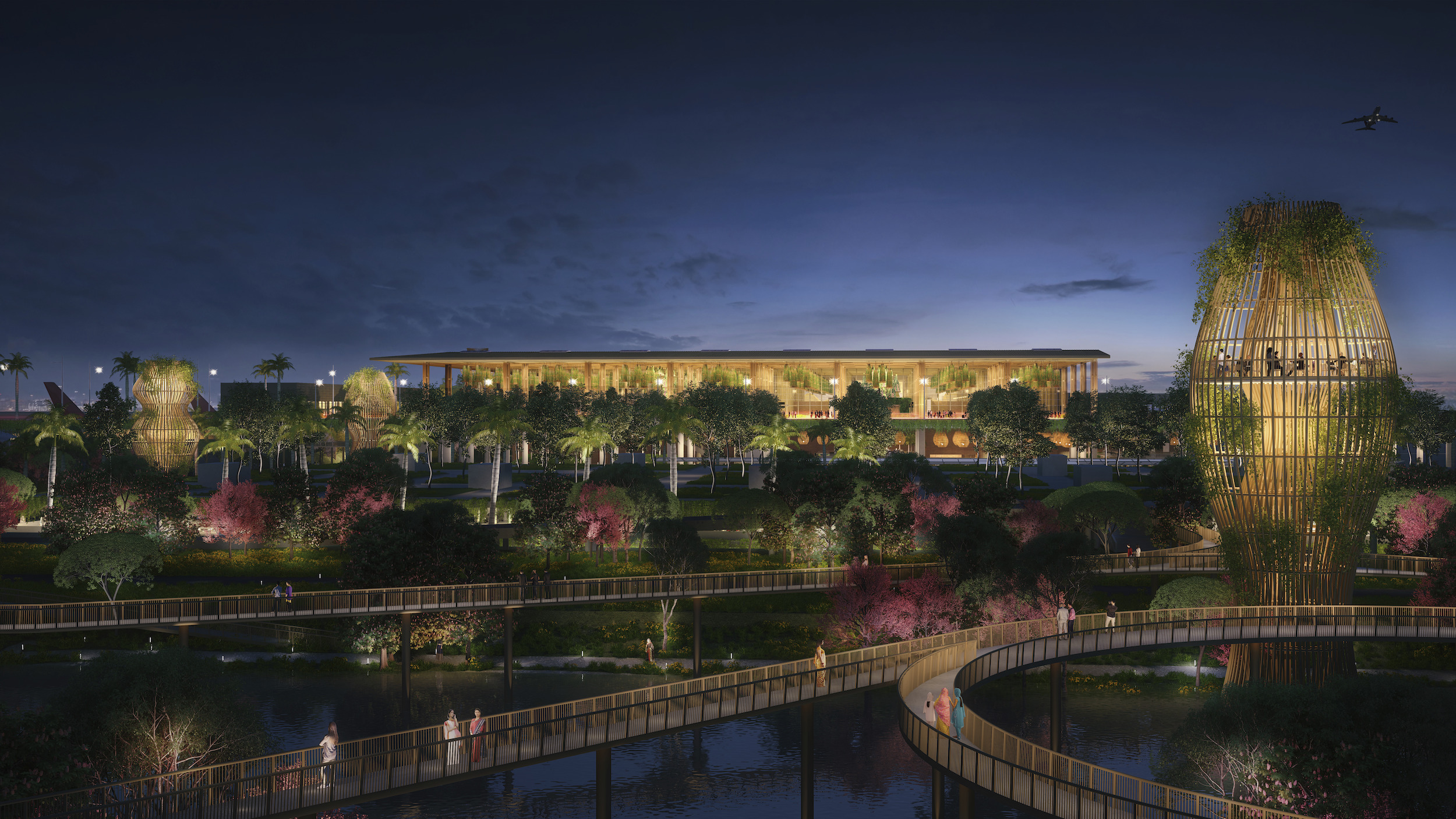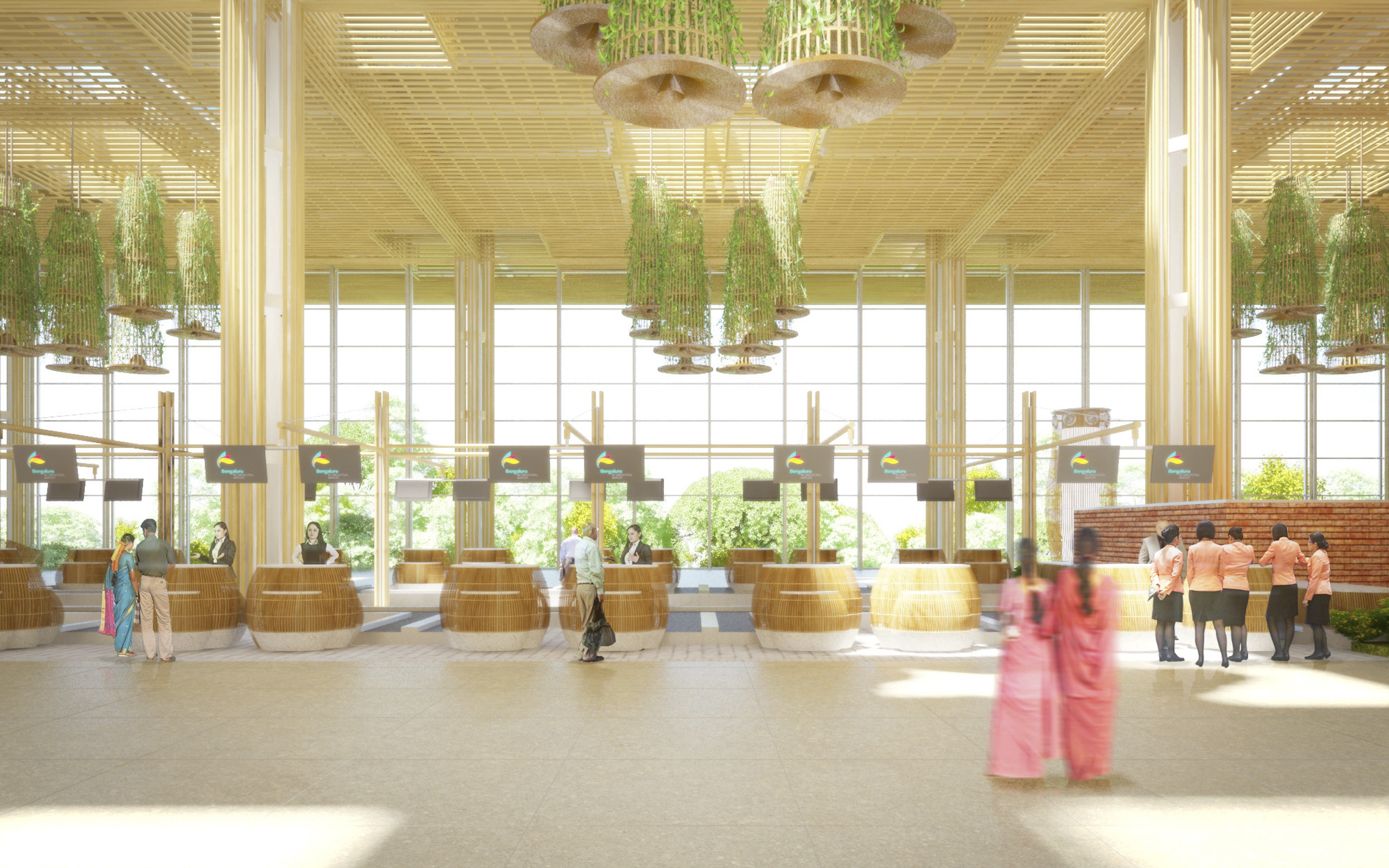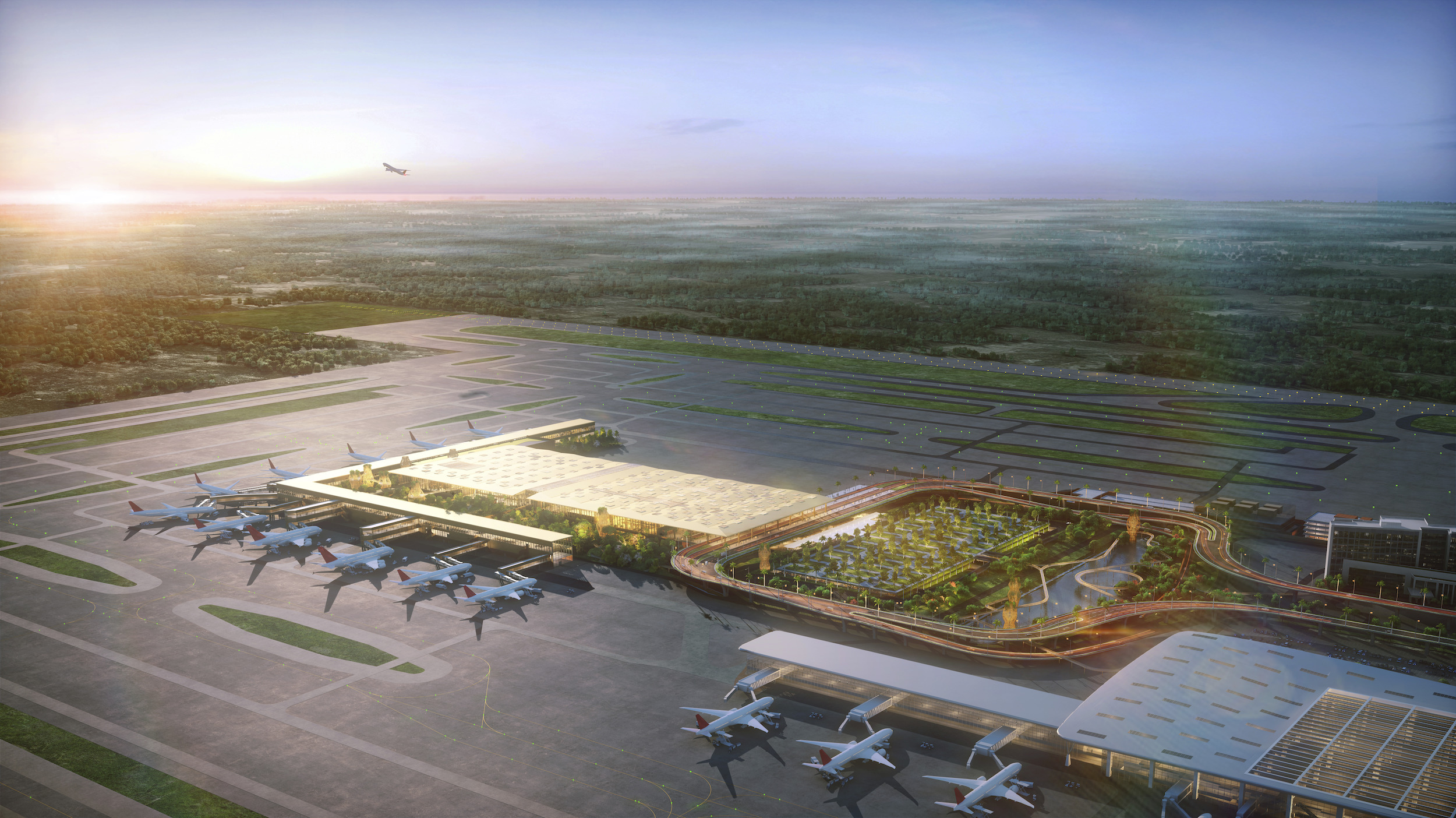Incorporating biophilia into a building’s architectural design has found its fullest expression lately in airports. Setting the bar when it opened in 2019 was the nature-themed Jewel Changi Airport, designed by Safdie Architects, which features an expansive indoor forest and a rain-fed waterfall that, at 40 meters, is the world’s tallest.
On January 15, 2023, Phase 1 of the Kempegowda International Airport’s Terminal 2, in Bengaluru, India, began domestic operations. The 255,661-sm (2.75 million-sf) building, designed by Skidmore, Owings & Merrill (SOM), is projected to process 25 million passengers annually, while providing its travelers with a healthier environment, thanks to extensive indoor-outdoor landscaping that offers serenity to what is normally a frenzied experience.
Phase 1 of Terminal 2 “allows for a sense of wonder and delight” with its outdoor gardens and exotic plants, says Peter Lefkovits, a Partner with SOM, whom BD+C interviewed a few weeks after the terminal opened. The building team on this project included the structural, civil, and facade engineer Buro Happold, which also provided structural and façades engineering services for the Jewel Changi Airport.
Airport terminal offers a natural connection to the outdoors
SOM’s involvement in the Kempegowda Airport project dates back to 2013, when it won a design competition. It worked with Arup on this project's MEP design. Lefkovits recalls that the client, Bangalore International Airport Ltd. (BIAL), “from the get-go” wanted its new terminal to reflect Bengaluru, known locally as the Garden City for its lush parks and gardens, and temperate climate despite being in southern India.
“We give the airport a lot of credit for its vision for a model of sustainability, even pre-pandemic,” says Lefkovits.
Working with the landscape architect Grant Associates and the lighting consultant Brandston Partnership Inc., SOM devised a terminal within a garden that connects passengers to nature. Travelers walking through the airport are exposed to more than 10,000 sm of green walls, hanging plants, and gardens inside a terminal whose buildings are interconnected by a continuous band of outdoor landscaped spaces.

The main complex—which encompasses areas for check-in, baggage dropoff, and security checkpoints—is linked to an 11-gate boarding building by an outdoor, 24,000-sm “forest belt” that rises three stories and includes a series of open-air bridges for departures (upper floor) and arrivals (lower floor). Lefkovits notes that there’s a separate network of walkways that allows passengers to meander through the forest.
The outdoor garden surrounds a large lagoon that supports a nursery for maintaining the terminal’s plant life and provides graywater for the terminal’s operations.
The plant species throughout the terminal were chosen for their ruggedness. The flora has its own integrated irrigation system that is monitored by apps. Lefkovits adds that the plants were often placed to take advantage of the terminal’s skylights.
Bamboo abounds as a design feature of the airport terminal
From Day 1, the Building Team, which included the general contractor Larsen + Toubro and CM Turner Construction, worked under a specific budget that was set by regulatory authorities. Consequently, the building’s design is clean, efficient, and simple, Lefkovits says, without “structural gestures” and at the service of the gardens and passenger comfort.
The team used a “rich palette” of building materials that included domestic granite for the terminal’s flooring, and natural brick for its walls. “It doesn’t feel like an airport as much as a hotel,” says Lefkovits.
Contributing to that ambiance within the terminal is an abundance of hanging plants and natural light that filters through bamboo lattice. Indoor waterfalls in the building’s retail section help cool the interior. Terminal 2 also has one of the lightest roofs at this scale, made entirely from domestically produced materials. The roof above the retail and check-in halls features long-span steel frames supported by steel columns 18 meters apart, whose posts are clad in bamboo.

At the center of Kempegowda Airport, with Terminal 2 to its north and Terminal 1 to its southeast, is a 123,000-sm, T-shaped multimodal transit hub, the artery through which the entire complex can be accessed. As if a terminal within a garden isn’t unusual enough, the transit hub features an outdoor retail and entertainment area that the airport has positioned as a new civic center for the city. The gardens from Terminal 2 extend to the hub and its surrounding land. Two lagoons on the hub’s southern side recycle the airport’s stormwater runoff.
Related: BD+C's 2022 Airport Terminal Giants:
• Top 55 Airport Terminal Architecture and AE Firms
• Top 65 Airport Terminal Engineering and EA Firms
• Top 60 Airport Terminal Contractors and CM Firms
India’s Ministry of Civil Aviation estimated that Terminal 2 cost “around” 50 billion rupees to build, or the equivalent of US$604 million. Terminal 2 was designed and constructed to achieve LEED Gold certification. The building is run entirely on renewable energy. The terminal’s second phase, for which no start date has been announced yet, will increase its size to 450,000 sm, and its annual traveler capacity to 40 million.
Related Stories
| Jul 2, 2014
Emerging trends in commercial flooring
Rectangular tiles, digital graphic applications, the resurgence of terrazzo, and product transparency headline today’s commercial flooring trends.
| Jun 30, 2014
Arup's vision of the future of rail: driverless trains, maintenance drones, and automatic freight delivery
In its Future of Rail 2050 report, Arup reveals a vision of the future of rail travel in light of trends such as urban population growth, climate change, and emerging technologies.
| Jun 18, 2014
Arup uses 3D printing to fabricate one-of-a-kind structural steel components
The firm's research shows that 3D printing has the potential to reduce costs, cut waste, and slash the carbon footprint of the construction sector.
| Jun 12, 2014
Austrian university develops 'inflatable' concrete dome method
Constructing a concrete dome is a costly process, but this may change soon. A team from the Vienna University of Technology has developed a method that allows concrete domes to form with the use of air and steel cables instead of expensive, timber supporting structures.
| Jun 2, 2014
Parking structures group launches LEED-type program for parking garages
The Green Parking Council, an affiliate of the International Parking Institute, has launched the Green Garage Certification program, the parking industry equivalent of LEED certification.
| May 29, 2014
7 cost-effective ways to make U.S. infrastructure more resilient
Moving critical elements to higher ground and designing for longer lifespans are just some of the ways cities and governments can make infrastructure more resilient to natural disasters and climate change, writes Richard Cavallaro, President of Skanska USA Civil.
| May 23, 2014
Top interior design trends: Gensler, HOK, FXFOWLE, Mancini Duffy weigh in
Tech-friendly furniture, “live walls,” sit-stand desks, and circadian lighting are among the emerging trends identified by leading interior designers.
| May 20, 2014
Kinetic Architecture: New book explores innovations in active façades
The book, co-authored by Arup's Russell Fortmeyer, illustrates the various ways architects, consultants, and engineers approach energy and comfort by manipulating air, water, and light through the layers of passive and active building envelope systems.
| May 19, 2014
What can architects learn from nature’s 3.8 billion years of experience?
In a new report, HOK and Biomimicry 3.8 partnered to study how lessons from the temperate broadleaf forest biome, which houses many of the world’s largest population centers, can inform the design of the built environment.
| May 13, 2014
19 industry groups team to promote resilient planning and building materials
The industry associations, with more than 700,000 members generating almost $1 trillion in GDP, have issued a joint statement on resilience, pushing design and building solutions for disaster mitigation.

















